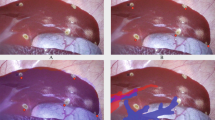Abstract
Limitations associated with the visual information provided to surgeons during laparoscopic surgery increases the difficulty of procedures and thus, reduces clinical indications and increases training time. This work presents a novel augmented reality visualization approach that aims to improve visual data supplied for the targeting of non visible anatomical structures in laparoscopic visceral surgery. The approach aims to facilitate the localisation of hidden structures with minimal damage to surrounding structures and with minimal training requirements. The proposed augmented reality visualization approach incorporates endoscopic images overlaid with virtual 3D models of underlying critical structures in addition to targeting and depth information pertaining to targeted structures. Image overlay was achieved through the implementation of camera calibration techniques and integration of the optically tracked endoscope into an existing image guidance system for liver surgery. The approach was validated in accuracy, clinical integration and targeting experiments. Accuracy of the overlay was found to have a mean value of 3.5 mm ± 1.9 mm and 92.7% of targets within a liver phantom were successfully located laparoscopically by non trained subjects using the approach.
Access this chapter
Tax calculation will be finalised at checkout
Purchases are for personal use only
Preview
Unable to display preview. Download preview PDF.
Similar content being viewed by others
References
Veldkamp, R., Kuhry, E., Hop, W., Jeekel, J., Kazemier, G., Bonjer, H.J., Haglind, E., Påhlman, L., Cuesta, M., Msika, S., Morino, M., Lacy, A.: Laparoscopic surgery versus open surgery for colon cancer: short-term outcomes of a randomised trial. The Lancet Oncology 6(7), 477–484 (2005)
Buell, J., Cherqui, D., Geller, D., O’Rourke, N., Iannitti, D., Dagher, I., et al.: The International Position on Laparoscopic Liver Surgery. Annals of Surgery 250(5), 825–830 (2009)
Marescaux, J., Rubino, F., Arenas, M., Mutter, D., Soler, L.: Augmented-Reality-Assisted Laparoscopic Adrenalectomy. JAMA 292(18), 2214–2215 (2004)
Nicolau, S., Pennec, X., Soler, L., Buy, X., Gangi, A., Ayache, N., Marescaux, J.: An augmented reality system for liver thermal ablation: design and evaluation on clinical cases. Medical Image Analysis 13(3), 494–506 (2009)
Soler, L., Nicolau, S., Hostettler, A., Fasquel, J., Agnus, V., Charnoz, A.: Computer Assisted Digestive Surgery, Computational Surgery and Dual Training, 2010th edn., pp. 139–153. Springer, US (2010)
Hong, J., Sungmin, K., Hashizume, M., Cho, H.: Endoscopic image overlay surgical navigation using augmented and virtual reality technologies. In: Proceedings of 2011 8th Asian Control Conference (ASCC), May 15, pp. 574–578 (2011)
Winne, C., Khan, M., Stopp, F., Jank, E., Keeve, E.: Overlay visualization in endoscopic ENT surgery. International Journal of Computer Assisted Radiology and Surgery 6(3), 401–406 (2010)
Nicolau, S., Soler, L., Mutter, D., Marescaux, J.: Augmented reality in laparoscopic surgical oncology. Surgical Oncology 20(3), 189–201 (2011)
Peterhans, M., vom Berg, A., Dagon, B., Inderbitzin, D., Baur, C., Candinas, D., Weber: A navigation system for open liver surgery: design, workflow and first clinical applications. The International Journal of Medical Robotics + Computer Assisted Surgery: MRCAS 7(1), 7–16 (2011)
Schenk, A., Zidowitz, S., Bourquain, H., Hindennach, M., Hansen, C., Hahn, H., Peitgen, H.O.: Clinical relevance of model based computer-assisted diagnosis and therapy. In: Proceedings of SPIE, vol. 6915(6), pp. 691502\1–691502\19 (June 2008)
Gavaghan, K.A., Peterhans, M., Oliveira-Santos, T., Weber, S.: A portable image overlay projection device for computer-aided open liver surgery. IEEE Transactions on Biomedical Engineering 58(6), 1855–1864 (2011)
Zhang, Z.: A flexible new technique for camera calibration. IEEE Transactions on Pattern Analysis and Machine Intelligence 22(11), 1330–1334 (2000)
Li, S., Zhang, G., Wei, Z.: The determination of the intrinsic and extrinsic parameters of virtual camera based on OpenGL. In: Proceedings of SPIE, vol. 6358, pp. 63581C–63581C-6 (2006)
Gavaghan, K.A., Anderegg, S., Peterhans, M., Oliveira-Santos, T., Weber, S.: Augmented Reality Image Overlay Projection for Image Guided Open Liver Ablation of Metastatic Liver Cancer. In: Linte, C.A., Moore, J.T., Chen, E.C.S., Holmes III, D.R. (eds.) AE-CAI 2011. LNCS, vol. 7264, pp. 36–46. Springer, Heidelberg (2012)
Glossop, N.D.: Advantages of optical compared with electromagnetic tracking. The Journal of Bone and Joint Surgery 91(suppl. 1), 23–28 (2009)
Yaniv, Z., Wilson, E., Lindisch, D., Cleary, K.: Electromagnetic tracking in the clinical environment. Medical Physics 36(3), 876 (2009)
Heizmann, O., Zidowitz, S., Bourquain, H., Potthast, S., Peitgen, H.O., Oertli, D., Kettelhack, C.: Assessment of intraoperative liver deformation during hepatic resection: prospective clinical study. World Journal of Surgery 34(8), 1887–1893 (2010)
Ribes, D., Peterhans, M., Wallach, D., Banz, V., Stavrou, G., Weber, S.: US/CT registration framework for higher instrument guidance accuracy in open liver surgery. In: CURAC 2012, Düsseldorf (2012)
Hansen, C., Wieferich, J., Ritter, F., Rieder, C., Peitgen, H.-O.: Illustrative visualization of 3D planning models for augmented reality in liver surgery. International Journal of Computer Assisted Radiology and Surgery 5(2), 133–141 (2010)
Author information
Authors and Affiliations
Editor information
Editors and Affiliations
Rights and permissions
Copyright information
© 2013 Springer-Verlag Berlin Heidelberg
About this paper
Cite this paper
Fusaglia, M. et al. (2013). Endoscopic Image Overlay for the Targeting of Hidden Anatomy in Laparoscopic Visceral Surgery. In: Linte, C.A., Chen, E.C.S., Berger, MO., Moore, J.T., Holmes, D.R. (eds) Augmented Environments for Computer-Assisted Interventions. AE-CAI 2012. Lecture Notes in Computer Science, vol 7815. Springer, Berlin, Heidelberg. https://doi.org/10.1007/978-3-642-38085-3_3
Download citation
DOI: https://doi.org/10.1007/978-3-642-38085-3_3
Publisher Name: Springer, Berlin, Heidelberg
Print ISBN: 978-3-642-38084-6
Online ISBN: 978-3-642-38085-3
eBook Packages: Computer ScienceComputer Science (R0)




